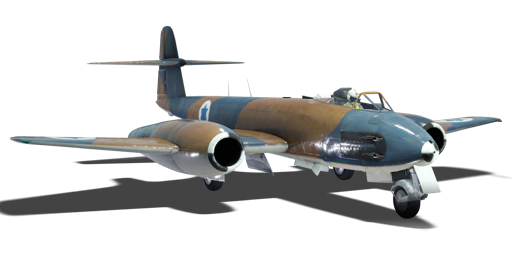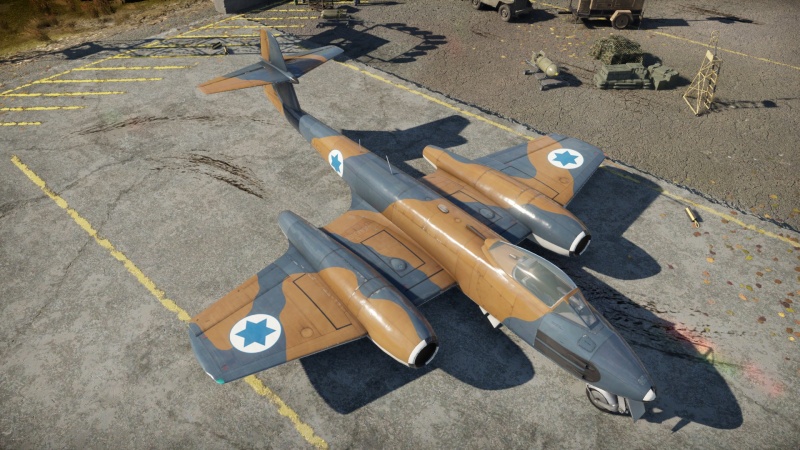Meteor F.8 (Israel)
Contents
Description
The Meteor F Mk.8 is a rank V Israeli jet fighter with a battle rating of 7.7 (AB) and 8.0 (RB/SB). It was introduced in Update "Winged Lions".
General info
Flight performance
| Characteristics | Max Speed (km/h at 100 m) |
Max altitude (metres) |
Turn time (seconds) |
Rate of climb (metres/second) |
Take-off run (metres) | |||
|---|---|---|---|---|---|---|---|---|
| AB | RB | AB | RB | AB | RB | |||
| Stock | 920 | 897 | 12500 | 24.1 | 24.7 | 33.6 | 31.7 | 325 |
| Upgraded | 976 | 962 | 22.2 | 23.0 | 47.4 | 40.2 | ||
Details
| Features | |||||
|---|---|---|---|---|---|
| Combat flaps | Take-off flaps | Landing flaps | Air brakes | Arrestor gear | Drogue chute |
| ✓ | ✓ | ✓ | ✓ | X | X |
| Limits | ||||||
|---|---|---|---|---|---|---|
| Wings (km/h) | Gear (km/h) | Flaps (km/h) | Max Static G | |||
| Combat | Take-off | Landing | + | - | ||
| 0 | 390 | 495 | 462 | 290 | ~11 | ~5 |
| Optimal velocities (km/h) | |||
|---|---|---|---|
| Ailerons | Rudder | Elevators | Radiator |
| < 560 | < 600 | < 620 | N/A |
Engine performance
| Engine | Aircraft mass | |||||
|---|---|---|---|---|---|---|
| Engine name | Number | Basic mass | Wing loading (full fuel) | |||
| Rolls-Royce Derwent 8 | 2 | 5,496 kg | 216 kg/m2 | |||
| Engine characteristics | Mass with fuel (no weapons load) | Max Takeoff Weight | ||||
| Weight (each) | Type | 7m fuel | 20m fuel | 23m fuel | ||
| 443 kg | Centrifugal-flow turbojet | 5,953 kg | 6,796 kg | 7,020 kg | 8,061 kg | |
| Maximum engine thrust @ 0 m (RB/SB) | Thrust to weight ratio @ 0 m (100%) | |||||
| Condition | 100% | WEP | 7m fuel | 20m fuel | 23m fuel | MTOW |
| Stationary | 1,633 kgf | N/A | 0.55 | 0.48 | 0.47 | 0.41 |
| Optimal | 1,633 kgf (0 km/h) |
N/A | 0.55 | 0.48 | 0.47 | 0.41 |
Survivability and armour
Examine the survivability of the aircraft. Note how vulnerable the structure is and how secure the pilot is, whether the fuel tanks are armoured, etc. Describe the armour, if there is any, and also mention the vulnerability of other critical aircraft systems.
Modifications and economy
Armaments
Offensive armament
The Meteor F.8 (Israel) is armed with:
- 4 x 20 mm Hispano Mk.V cannons, nose-mounted (200 rpg upper + 190 rpg lower = 780 total)
Suspended armament
The Meteor F.8 (Israel) can be outfitted with the following ordnance:
- Without load
- 8 x AR rockets
Usage in battles
Describe the tactics of playing in the aircraft, the features of using aircraft in a team and advice on tactics. Refrain from creating a "guide" - do not impose a single point of view, but instead, give the reader food for thought. Examine the most dangerous enemies and give recommendations on fighting them. If necessary, note the specifics of the game in different modes (AB, RB, SB).
Pros and cons
Summarise and briefly evaluate the vehicle in terms of its characteristics and combat effectiveness. Mark its pros and cons in the bulleted list. Try not to use more than 6 points for each of the characteristics. Avoid using categorical definitions such as "bad", "good" and the like - use substitutions with softer forms such as "inadequate" and "effective".
Pros:
Cons:
History
First flown on March 5, 1943, the Meteor became the RAF's first operational jet when it entered service with No. 616 squadron on 12th July 1944. It was the only allied jet fighter to enter service before the end of the WWII, making its operational debut against V-1 flying bombs launched against southern England. Numerous variants were developed after the war to provide fighters, trainers and photo reconnaissance aircraft, the F-8 variant serving as the RAF's major single seat day fighter during the early 1950s.
The Middle East entered the jet age in October 1949 when the Egpytian Air Force (EAF) received its first jet fighters, Meteor F.4s. By the end of 1952 the EAF had 49 jets (23 Meteors and 26 de Havilland Vampires) in its inventory, with more expected shortly, at a time when the most advanced fighter operated by the IAF was the North American P-51D Mustang, a World War II veteran. Israel had made several attempts to purchase jets from the USA and other European nations beginning in 1950, but these were rejected every time. In August 1952 the British government declared its willingness to sell 14 Meteors to each Middle Eastern nation, seeking to increase its weapons sales while keeping an impartial position. The IAF had long before come to the conclusion that there was no competing with the Arabs on quantity and that Israel had therefore to rely on quality, a stance contrary to the current offer. No nation besides Britain however, would sell jet fighters to Israel and Israel could not stand by while the balance of power was shifting against its favor. On November 23, 1952, the Israeli government approved the purchase and on February 1st 1953 the IAF and Gloster signed a deal for 11 Meteor F.8s and 4 training T.7s. These were the first aircraft the IAF had ever purchased from the manufacturer instead of second-hand examples.
Israel was the third Middle Eastern state to get the Meteor, after Egypt and Syria. These aircraft were delivered in three batches. In 1953 Israel received four T Mk.7s and eleven F Mk.8s, all new aircraft. The F Mk.8s were modified to carry American HVAR rockets but were otherwise identical to RAF aircraft.
The delivery of the F.8s begun on August 21st 1953 and was completed on January 17th 1954. The same year saw the IAF begin negotiations for the procurement of 2 T.7s and 9 Meteor FR.9, an armed tactical reconnaissance variant similar to the F.8. The first pair of FR.9s arrived in January 1955 and by May all 9 aircraft were in Israel. Two of these were later converted to F.8 standard while another 5 were stripped of their reconnaissance apparatus and were employed as mere fighters.
Even though the Air Force's French era was at the gate, and the Ouragan and Mystere planes replaced them as first line aircraft within two years, the British Meteors were able to take credit for a number of important activities. Among them, shooting down two Egyptian Vampires in the first jet aerial battle in the Middle East, which took place in September 1955 and shooting down the plane of the Egyptian Army's General Staff, Just before the Kadesh war.
In these twin-engine jet planes generations of jet pilots were trained as the Meteors served as operational training planes for combat pilots, and later on in a more advanced stage of the flight school. Meteors converted for photography, performed sorties deep in enemy territory and served as conversion planes for twin-engined fighter squadrons.
The Mk.8s remained in front line service until 1956, when they began to be replaced by the Dassault Mystere. They were then used as training aircraft.
Media
Excellent additions to the article would be video guides, screenshots from the game, and photos.
See also
Links to the articles on the War Thunder Wiki that you think will be useful for the reader, for example:
- reference to the series of the aircraft;
- links to approximate analogues of other nations and research trees.
External links
Paste links to sources and external resources, such as:
- topic on the official game forum;
- other literature.
| Gloster Aircraft Company, Limited | |
|---|---|
| Fighters | Gladiator Mk II · Sea Gladiator Mk I · Gladiator Mk IIF · Gladiator Mk IIS · Tuck's Gladiator Mk II |
| Jet Fighters | Meteor F Mk 3 · Sea Meteor F Mk 3 · Meteor F Mk 4 G.41F · Meteor F Mk 4 G.41G · Meteor F Mk 8 G.41K · Meteor F Mk.8 Reaper |
| Javelin F.(A.W.) Mk.9 | |
| Export | J8A · Iacobi's J8A · ␗Gladiator Mk I · ▄Gladiator Mk I |
| ▄Meteor F Mk.8 · Meteor F.8 · Meteor NF.13 | |
| See Also | Fokker |
| Israel jet aircraft | |
|---|---|
| Kfir Canard · Kfir C.2 · Kfir C.7 · Nesher | |
| Britain | |
| Meteor | Meteor NF.13 · Meteor F.8 |
| France | |
| Vautour | Vautour IIA · Vautour IIN |
| Super Mystere | Sambad · Sa'ar |
| Mirage III | Shahak |
| Other | M.D.450B Ouragan · Mystere IVA |
| USA | |
| F-84 | F-84F |
| A-4 | A-4H · A-4E Early (M) · A-4E · Ayit |
| F-4 | Kurnass · Kurnass 2000 |
| F-15 | Baz · Baz Meshupar · F-15I Ra’am |
| F-16 | Netz · F-16C Barak II · F-16D Barak II |





